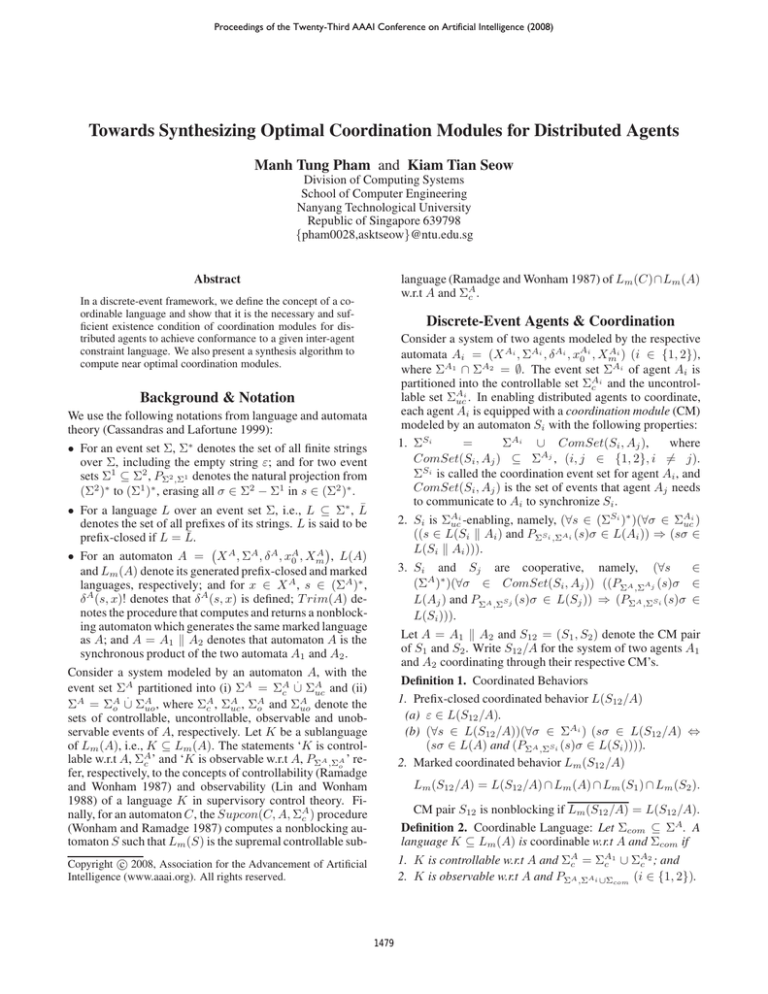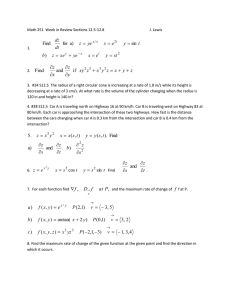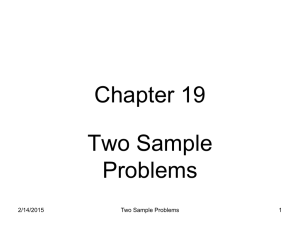
Proceedings of the Twenty-Third AAAI Conference on Artificial Intelligence (2008)
Towards Synthesizing Optimal Coordination Modules for Distributed Agents
Manh Tung Pham and Kiam Tian Seow
Division of Computing Systems
School of Computer Engineering
Nanyang Technological University
Republic of Singapore 639798
{pham0028,asktseow}@ntu.edu.sg
language (Ramadge and Wonham 1987) of Lm (C)∩Lm (A)
w.r.t A and ΣA
c .
Abstract
In a discrete-event framework, we define the concept of a coordinable language and show that it is the necessary and sufficient existence condition of coordination modules for distributed agents to achieve conformance to a given inter-agent
constraint language. We also present a synthesis algorithm to
compute near optimal coordination modules.
Discrete-Event Agents & Coordination
Consider a system of two agents modeled by the respective
Ai
i
automata Ai = (X Ai , ΣAi , δ Ai , xA
0 , Xm ) (i ∈ {1, 2}),
A2
A1
where Σ ∩ Σ = ∅. The event set ΣAi of agent Ai is
i
partitioned into the controllable set ΣA
c and the uncontroli
lable set ΣA
.
In
enabling
distributed
agents
to coordinate,
uc
each agent Ai is equipped with a coordination module (CM)
modeled by an automaton Si with the following properties:
where
1. ΣSi
=
ΣAi ∪ ComSet(Si , Aj ),
ComSet(Si , Aj ) ⊆ ΣAj , (i, j ∈ {1, 2}, i 6= j).
ΣSi is called the coordination event set for agent Ai , and
ComSet(Si , Aj ) is the set of events that agent Aj needs
to communicate to Ai to synchronize Si .
Si ∗
Ai
i
2. Si is ΣA
uc -enabling, namely, (∀s ∈ (Σ ) )(∀σ ∈ Σuc )
((s ∈ L(Si k Ai ) and PΣSi ,ΣAi (s)σ ∈ L(Ai )) ⇒ (sσ ∈
L(Si k Ai ))).
3. Si and Sj are cooperative, namely, (∀s
∈
A ∗
A
(Σ ) )(∀σ ∈ ComSet(Si , Aj )) ((PΣA ,Σ j (s)σ ∈
L(Aj ) and PΣA ,ΣSj (s)σ ∈ L(Sj )) ⇒ (PΣA ,ΣSi (s)σ ∈
L(Si ))).
Let A = A1 k A2 and S12 = (S1 , S2 ) denote the CM pair
of S1 and S2 . Write S12 /A for the system of two agents A1
and A2 coordinating through their respective CM’s.
Definition 1. Coordinated Behaviors
1. Prefix-closed coordinated behavior L(S12 /A)
(a) ε ∈ L(S12 /A).
(b) (∀s ∈ L(S12 /A))(∀σ ∈ ΣAi ) (sσ ∈ L(S12 /A) ⇔
(sσ ∈ L(A) and (PΣA ,ΣSi (s)σ ∈ L(Si )))).
2. Marked coordinated behavior Lm (S12 /A)
Background & Notation
We use the following notations from language and automata
theory (Cassandras and Lafortune 1999):
• For an event set Σ, Σ∗ denotes the set of all finite strings
over Σ, including the empty string ε; and for two event
sets Σ1 ⊆ Σ2 , PΣ2 ,Σ1 denotes the natural projection from
(Σ2 )∗ to (Σ1 )∗ , erasing all σ ∈ Σ2 − Σ1 in s ∈ (Σ2 )∗ .
• For a language L over an event set Σ, i.e., L ⊆ Σ∗ , L̄
denotes the set of all prefixes of its strings. L is said to be
prefix-closed if L = L̄.
A
• For an automaton A = X A , ΣA , δ A , xA
0 , Xm , L(A)
and Lm (A) denote its generated prefix-closed and marked
languages, respectively; and for x ∈ X A , s ∈ (ΣA )∗ ,
δ A (s, x)! denotes that δ A (s, x) is defined; T rim(A) denotes the procedure that computes and returns a nonblocking automaton which generates the same marked language
as A; and A = A1 k A2 denotes that automaton A is the
synchronous product of the two automata A1 and A2 .
Consider a system modeled by an automaton A, with the
.
A
event set ΣA partitioned into (i) ΣA = ΣA
c ∪ Σuc and (ii)
.
A
A
A
A
A
A
A
Σ = Σo ∪ Σuo , where Σc , Σuc , Σo and Σuo denote the
sets of controllable, uncontrollable, observable and unobservable events of A, respectively. Let K be a sublanguage
of Lm (A), i.e., K ⊆ Lm (A). The statements ‘K is controllable w.r.t A, ΣA
’ rec ’ and ‘K is observable w.r.t A, PΣA ,ΣA
o
fer, respectively, to the concepts of controllability (Ramadge
and Wonham 1987) and observability (Lin and Wonham
1988) of a language K in supervisory control theory. Finally, for an automaton C, the Supcon(C, A, ΣA
c ) procedure
(Wonham and Ramadge 1987) computes a nonblocking automaton S such that Lm (S) is the supremal controllable sub-
Lm (S12 /A) = L(S12 /A) ∩ Lm (A) ∩ Lm (S1 ) ∩ Lm (S2 ).
CM pair S12 is nonblocking if Lm (S12 /A) = L(S12 /A).
Definition 2. Coordinable Language: Let Σcom ⊆ ΣA . A
language K ⊆ Lm (A) is coordinable w.r.t A and Σcom if
A2
A1
1. K is controllable w.r.t A and ΣA
c = Σc ∪ Σc ; and
2. K is observable w.r.t A and PΣA ,ΣAi ∪Σcom (i ∈ {1, 2}).
c 2008, Association for the Advancement of Artificial
Copyright Intelligence (www.aaai.org). All rights reserved.
1479
Theorem 1. Let ∅ 6= K ⊆ Lm (A) and Σcom ⊆ ΣA . Then,
there exists a nonblocking CM pair S12 = (S1 , S2 ), with
CM Si for Ai , such that Lm (S12 /A) = K and Σcom =
ComSet(S1 , A2 ) ∪ ComSet(S2 , A1 ), if and only if K is
coordinable w.r.t A and Σcom .
Lm (S), CM’s S1 and S2 can be computed such that ΣSi =
ΣAi ∪ M inComSet(Lm (S), Ai , Aj ).
Finally, the reduction procedure Supreduce presented in
(Su and Wonham 2004) could be modified as procedure
CM reduce, in attempting to address the efficient implemeni
tation of CM’s Si . Procedure CM reduce(Si , A, ΣA
c ) can
often return a greatly state-size reduced CM for agent Ai
achieving the same behavior of Si k A.
Problem Statement and Solution Properties
Problem. Multiagent Coordination Problem (MCP): Given
an inter-agent constraint automaton C over ΣA , construct a nonblocking CM pair S12 = (S1 , S2 ) such that
Lm (S12 /A) ⊆ Lm (A) ∩ Lm (C).
Coordination Module Synthesis
In what follows, the discrete-event techniques of control and
sensor selection can be adapted and utilized to address MCP
as in the algorithm below. The CM’s returned by the algorithm are minimally interventive and entail minimal communication, but have a relatively small state size that is not
necessarily minimal; hence they are said to be near optimal.
When solving MCP, it is desirable to synthesize optimal
CM’s, i.e., CM’s with the following properties: 1) Minimal
Intervention - the coordination does not unnecessarily disable controllable events; 2) Minimal Communication - the
number of events to be communicated between the agents
is minimal; and 3) Efficient Implementation - each CM is of
minimal state size (among all CM’s satisfying the first two
properties).
A
A1
A2
Let S = Supcon(C, A, ΣA
c ), where Σc = Σc ∪ Σc .
Then minimal intervention can be guaranteed by synthesizing CM’s S1 and S2 such that Lm (S12 /A) = Lm (S). Procedure CM below computes CM’s Si given S, system event
set ΣA , and event set ΣCMi ⊆ ΣA for ΣSi = ΣCMi . By the
constructive proof of Theorem 1 presented elsewhere, it can
be shown that if Lm (S) is coordinable w.r.t A and ΣCM1 ∪
ΣCM2 and Si = CM (S, A, ΣCMi ) (i ∈ {1, 2}), the CM
pair (S1 , S2 ) is nonblocking and Lm (S12 /A) = Lm (S).
Algorithm: Coordination Module Synthesis
1
2
3
Procedure CM (S, ΣA , ΣCMi )
1
begin
S
Let π : Xp → 2X − {∅} be a bijective mapping;
′
S′
4
S′
5
6
Compute automaton Si′ = (ΣCMi , Xp , δ Si , x0 i , Xmi ):
2
S′
• x0 i ∈ Xp with
Input: Agents A1 , A2 and constraint C where
ΣC = ΣA1 ∪ ΣA2 and ΣA1 ∩ ΣA2 = ∅
Output: A near optimal nonblocking CM pair
S12 = (S1 , S2 ) such that
Lm (S12 /A) ⊆ Lm (A) ∩ Lm (C)
begin
Compute automaton A and controllable set ΣA
c
A1
A2
A ← A1 k A2 ; ΣA
c ← Σc ∪ Σc ;
Compute a nonblocking supervisor S
S ← Supcon(C, A, ΣA
c );
Compute coordination event sets ΣCM1 , ΣCM2
ΣCMi ← ΣAi ∪ M inComSet(Lm (S), Ai , Aj ),
(i, j ∈ {1, 2});
Compute CM’s S1 , S2
Si ← CM (S, A, ΣCMi ), (i ∈ {1, 2});
Reduce state size of CM’s
i
Si ← CM reduce(Si , A, ΣA
c ), (i ∈ {1, 2});
Return CM pair S12 = (S1 , S2 );
end
S′
π(x0 i ) = {δ S (s, xS
0 ) | PΣA ,ΣCMi (s) = ε};
Conclusion
S′
• Xmi = {xp ∈ Xp | (∃s ∈ Lm (S))δ S (s, xS
0 ) ∈ π(xp )};
The contributions of this paper to discrete-event multiagent
coordination include the existence condition (Theorem 1) of
CM’s and a synthesis algorithm for near optimal CM design.
′
• (∀σ ∈ ΣCMi )(∀xp ∈ Xp ) (δ Si (σ, xp )! if and only if
(∃sσ ∈ L(S))δ S (s, xS
0 ) ∈ π(xp ));
′
When defined, δ Si (σ, xp ) = x′p with
π(x′ p ) = {δ S (s′ , x) | x ∈ π(xp ), PΣA ,ΣCMi (s′ ) = σ};
References
Cassandras, C. G., and Lafortune, S. 1999. Introduction to Discrete Event Systems. Kluwer Academic Publishers, MA, USA.
Haji-Valizadeh, A., and Loparo, K. A. 1996. Minimizing the cardinality of an events set for supervisors of discrete-event dynamical systems. IEEE Trans. Autom. Control 41(11):1579–1593.
Lin, F., and Wonham, W. M. 1988. On observability of discrete
event systems. Inf. Sci. 44:173–198.
Ramadge, P. J., and Wonham, W. M. 1987. Supervisory control
of a class of discrete event processes. SIAM J. Control Optim.
25(1):206–230.
Su, R., and Wonham, W. M. 2004. Supervisor reduction for
discrete-event systems. Discret. Event Dyn. Syst.-Theory Appl.
14(1):31–53.
Wonham, W. M., and Ramadge, P. J. 1987. On the supremal
controllable sublanguage of a given language. SIAM J. Control
Optim. 25(3):637–659.
Return Si = T rim(Si′ );
3
end
Definition 3. Let L ⊆ Lm (A). A subset of ΣAj is a minimal
(cardinality) communication set of agent Ai from Aj w.r.t L,
and denoted by M inComSet(L, Ai , Aj ), if
1. L is observable w.r.t A, PΣA ,ΣAi ∪MinComSet(L,Ai ,Aj ) ;
A
j
2. (∀Σcom
⊆ ΣAj )(L is observable w.r.t A and
Aj
PΣA ,ΣAi ∪ΣAj )⇒ |M inComSet(L, Ai , Aj )| ≤ |Σcom
|.
com
The event set M inComSet(L, Ai , Aj ) could be computed by adapting the minimal sensor-selection algorithm
(Haji-Valizadeh and Loparo 1996). To guarantee minimal
communication between two agents coordinating to achieve
1480







